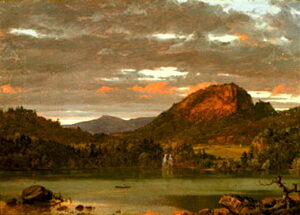Brauer Museum’s Controversial Deaccessioning

Frederic Edwin Church, Mountain Landscape, circa 1849, Brauer Museum of Art.
It appears likely that the sale of artworks from the Brauer Museum at Indiana’s Valparaiso University will go forward this year. The proposed sale is of three paintings, Georgia O’Keeffe’s “Rust Red Hills,” Frederic E. Church’s “Mountain Landscape” and Childe Hassam’s “The Silver Veil and the Golden Gate.” The paintings have an estimated value of more than $20 million.
University President Jose Padilla proposed the deaccession in October 2022 as a desperate measure to address faltering attendance at the school by upgrading long-neglected student dormitories. He stressed that proceeds for the sale would not be used for university general expenses, but be exclusively dedicated to improving the student experience – namely by the renovation of two of the university’s first year student residence halls.
On February 23, Valparaiso University’s Faculty Senate added their criticism to the proposed sale. Ninety present and emeritus faculty signed a letter presented to the Senate that described the proposed sale as a gross violation of museum ethics and as contrary to Lutheran intellectual tradition. Blog posts by faculty members discussing the scope of their response and the need to address severely declining student enrollment provide a more nuanced background to the controversy.

Childe Hassam, The Silver Veil and the Golden Gate, 1914, Brauer Museum of Art.
Richard Brauer, the museum’s founding direction after whom it is named, said that he would ask to have his name removed if the paintings are sold. He stated that the sale would violate the covenants of the restrictive trust that provided the artwork. The O’Keeffe was purchased for the university with the assistance of the trust in 1962 for $5,700. Brauer wrote to Padilla saying that a sale would, “wrongly reflect my approval of its utterly disgraceful, irreparably existentially diminishing, unethical and seemingly unnecessary, museum art collection sale actions!”
However, a university spokesperson told the Chicago Tribune on February 25th that the school would move forward with an auction sale of the paintings.
The Association of Art Museum Directors (AAMD) has threatened to sanction the museum for violating generally accepted standards that allow deaccession funds only to be used to purchase artworks and build the collection. The AAMD rules were temporarily relaxed at the height of the pandemic to allow museums to obtain essential funding for other museum-related expenses but have since been reinstated. Sanctions could result in a refusal of AAMD museum members to loan artwork or collaborate on exhibitions in the future.
Frankenthaler Foundation Grants Promote Clean Energy for Museums

Helen Frankenthaler in her studio, Contentment Island, Darien, Conn., in 2003, with her work “Blue Lady,” acrylic on paper. Author Lusine Gharibyan, Wikimedia Commons CCA-SA 4.0 International license.
The Helen Frankenthaler Foundation’s Climate Initiative announced that it is accepting grant requests for a third cycle of a total $10 million in grant opportunities to enable “clean, efficient energy usage” in U.S. visual art museums and art schools. Grant requests may be submitted to the Climate Initiative until March 31, 2023. Collecting and non-collecting institutions and visual arts schools may apply. The program offers three types of available grants:
- Scoping grants from $10-$25,000 are to analyze climate and energy mitigation opportunities at their facilities.
- Technical assistance grants from $25-$50,000 utilize the analyses to support developing efficiency projects to allow for procurement and financing.
- Implementation grants from $50-$100,000 provide partial seed funding for fully specified projects.
More advanced energy use will not only reduce costs and limit museums’ impact on climate change, it will also enable better care and conservation of the visual artworks stored, conserved, and exhibited in museum environments.
The Frankenthaler Foundation made grants related to climate change to 79 institutions in 2021 and 48 in 2022. The Foundation was endowed by the artist during her lifetime to serve a variety of philanthropic, educational, and research initiatives. The Foundation is an important contributor to arts and cultural organizations, with a more rapid response to crisis situations than other non-government funders, as exemplified in the Foundation’s support for Ukrainian artists and to protect cultural heritage in 2022. The Foundation also stewards the artist’s collection, her works and her archive.
 Georgia O'Keeffe, Rust Red Hills, 1930, Brauer Museum, Valparaiso University.
Georgia O'Keeffe, Rust Red Hills, 1930, Brauer Museum, Valparaiso University. 

